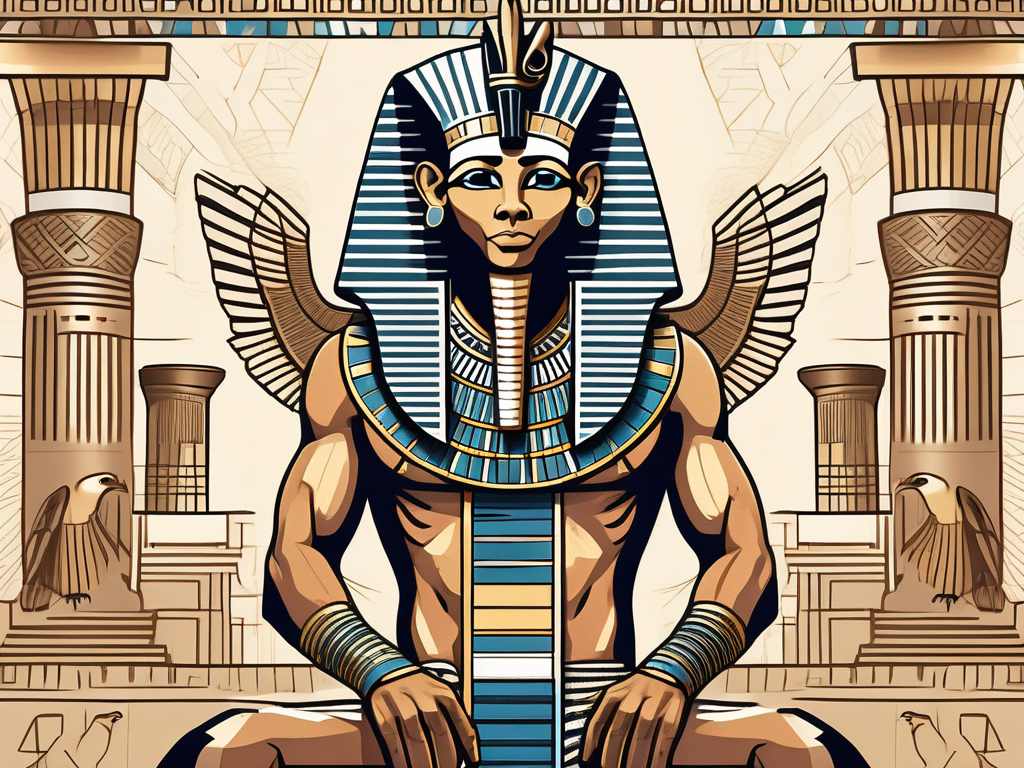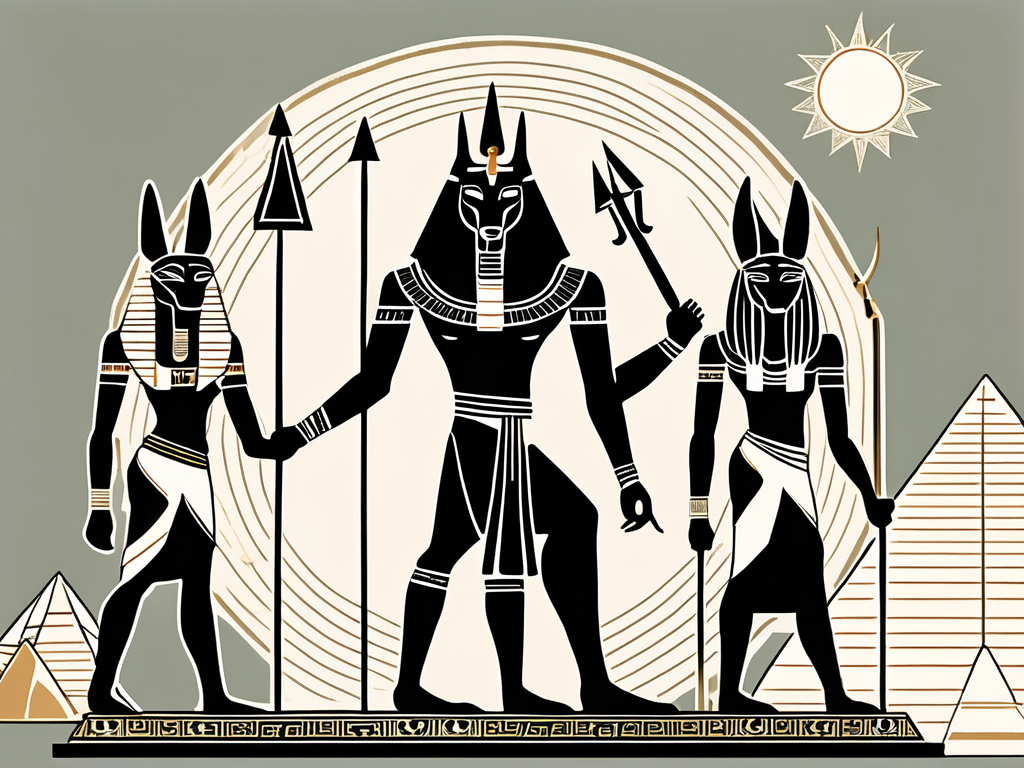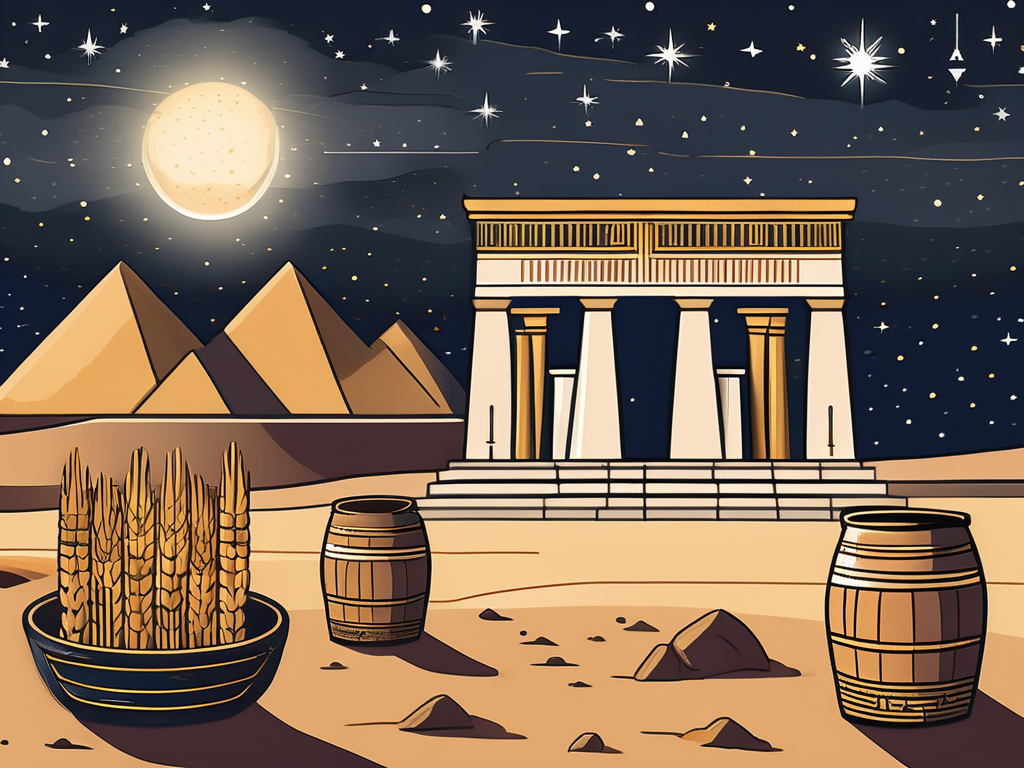In the ancient land of Egypt, where deities reigned supreme, one god stood out among the rest—Sobek. This fascinating god, often depicted as a crocodile-headed man, held a place of great significance in the complex Egyptian pantheon. Embark on a journey with me as we unravel the enigmatic allure of Sobek, exploring his role in ancient Egypt, his iconography, the worship and cult dedicated to him, his influence on modern culture, and even debunking some common misconceptions.
Understanding the Role of Sobek in Ancient Egypt
Within the rich tapestry of Egyptian mythology, Sobek occupied a unique and revered position. As a deity associated with the Nile, Sobek played a vital role in the agricultural prosperity of the land. The Egyptians believed that the annual flooding of the Nile was a result of Sobek’s presence, bringing life-giving waters to their crops. Moreover, Sobek was seen as a protector, both of the pharaoh and ordinary people, warding off evil forces and ensuring harmony and balance in society.
Sobek’s Place in the Egyptian Pantheon
As we delve deeper into the intricate pantheon of ancient Egypt, we discover the eminent status of Sobek among the gods. He was considered a son of the mighty creator deity, Atum, and further enhanced his divine lineage by being associated with Horus—the falcon-headed god—by some accounts. This connection demonstrated Sobek’s association with power and protection, symbolizing the unity of Upper and Lower Egypt.
Sobek and the Nile: A Symbolic Relationship
Sobek’s intimate relationship with the Nile River extended beyond the abstract. The crocodile, an animal closely associated with Sobek, was both feared and revered by the ancient Egyptians. It symbolized the mighty power of the Nile, its ability to both nurture and unleash destruction. The presence of crocodiles was seen as a sign that Sobek was watching over the land, protecting it from the chaos that lurked beyond the river’s banks.
Furthermore, the Nile River was not only a source of life but also a gateway to the afterlife. Egyptians believed that the deceased would embark on a perilous journey through the underworld, and the Nile served as a conduit for this passage. Sobek, as the guardian of the Nile, was believed to guide and protect souls as they made their way to the realm of the dead. His fierce and powerful nature instilled a sense of awe and reverence among the people, who sought his favor and protection in life and death.
Moreover, Sobek’s association with the Nile extended to the realm of fertility and creation. The annual flooding of the river not only brought water for irrigation but also deposited nutrient-rich silt on the surrounding farmland, ensuring bountiful harvests. Sobek was seen as the provider of this fertility, the force behind the abundance that sustained Egyptian society. The people offered prayers and sacrifices to Sobek, seeking his blessings for their crops and livestock, recognizing his role as the bringer of prosperity.
In addition to his agricultural significance, Sobek was also revered as a symbol of strength and ferocity. The crocodile, with its powerful jaws and formidable presence, embodied these qualities. Egyptians admired Sobek’s ability to protect and defend, attributing his strength to their own military prowess. Sobek was often invoked in times of war, with soldiers seeking his aid and guidance on the battlefield. His association with victory and triumph made him a beloved deity among warriors and leaders alike.
Furthermore, Sobek’s influence extended beyond the mortal realm. In the realm of magic and healing, Sobek was invoked as a deity capable of warding off illness and providing protection against malevolent spirits. His association with water and the Nile’s life-giving properties made him a natural choice for healing rituals and ceremonies. Temples dedicated to Sobek often housed sacred pools, believed to possess curative powers. Pilgrims would immerse themselves in these waters, seeking Sobek’s blessings for physical and spiritual well-being.
As we explore the multifaceted role of Sobek in ancient Egypt, we begin to grasp the depth of his influence and significance. From his association with the Nile and its life-sustaining properties to his role as a protector, provider, and symbol of strength, Sobek’s presence permeated every aspect of Egyptian society. His worship and reverence endured for centuries, a testament to the enduring power and importance of this ancient deity.
The Iconography of Sobek
Art played a crucial role in ancient Egypt, conveying ideas and ideologies through its intricate symbols and representations. Sobek’s iconography was no exception, capturing the essence of this powerful deity.
Sobek, the ancient Egyptian god of the Nile and fertility, was depicted in various forms of art that left a lasting impression on those who beheld them. When gazing upon the ancient sculptures and reliefs honoring Sobek, we can’t help but be struck by the imposing figure they convey. A crocodile-headed man with a regal posture, resplendent in divine attire, Sobek’s presence exuded strength and authority.
His fierce gaze and muscular physique epitomized the raw power that he held over the Nile and its denizens. The ancient artists skillfully captured Sobek’s essence, showcasing his dominance over the river and its fertile lands. The crocodile head symbolized his connection to the ferocious creatures that inhabited the Nile, while his human body represented his divine nature and ability to interact with humanity.
Depictions of Sobek often showcased his distinguishing characteristics, which added depth and symbolism to his iconography. One such attribute was his curved tail, sometimes entwined with lotus flowers—a symbol of fertility. This imagery emphasized Sobek’s role in the cycle of life and his association with the Nile’s life-giving waters. The solar disk adorning his crown further emphasized his close connection with the sun god, Ra, and his role in the celestial order of the universe.
Sobek’s iconography was not only visually captivating but also served a deeper purpose in Egyptian mythology. It reflected the intricate web of beliefs and interconnectedness of the gods in the ancient pantheon. Sobek’s imagery was a testament to the complexity and interwoven nature of Egyptian mythology, where deities often shared attributes and roles, blurring the lines between them.
Through the art of ancient Egypt, Sobek’s iconography brought forth a sense of awe and reverence for this powerful deity. The intricate details and symbolic elements showcased his dominion over the Nile, his connection to fertility, and his place within the divine order. These depictions not only served as visual representations but also as a means to convey the power and significance of Sobek in the ancient Egyptian worldview.
The Worship and Cult of Sobek
Temples dedicated to Sobek dotted the landscape of ancient Egypt, serving as focal points for his worship and veneration. The rituals and festivals held in his honor reflected the profound impact Sobek had on the lives and beliefs of the Egyptians.
Temples and Shrines Dedicated to Sobek
Among the most renowned sites dedicated to Sobek was the Temple of Kom Ombo, a magnificent structure strategically placed at a bend in the Nile, where worshippers could pay their respects and seek the god’s blessings. Within the temple’s halls, intricate reliefs and sculptures depicted Sobek in all his splendor, commemorating the vital role he played in their lives.
Rituals and Festivals in Honor of Sobek
Throughout the year, the ancient Egyptians celebrated Sobek through vibrant rituals and joyous festivals. These events saw priests adorned in elaborate ceremonial attire, exquisitely crafted boats sailing on the Nile, and processions carrying sacred statues of the god. Such festivities reinforced the bond between the people and Sobek, fostering a sense of community and shared devotion.
Sobek’s Influence on Modern Culture
Although the ancient world has long since passed, Sobek’s presence continues to resonate even in the modern era. His enigmatic persona has made its mark on various forms of media, literary works, and even tourism.
Sobek in Literature and Film
Authors and filmmakers have drawn inspiration from the intriguing mythology surrounding Sobek, incorporating his essence into their stories. From novels exploring ancient Egypt’s mysteries to blockbuster movies portraying mythical creatures, Sobek’s influence continues to captivate audiences, bridging the gap between past and present.
Sobek’s Impact on Egyptian Tourism
Egyptian tourism has always been intricately linked to the country’s rich history and cultural heritage. Sobek, with his formidable presence in mythology, has played a significant role in drawing visitors to Egypt. Many seek to explore the remnants of his worship and experience firsthand the awe-inspiring grandeur of Sobek’s temples, immersing themselves in a world steeped in ancient lore.
Debunking Myths about Sobek
As with any ancient figure, Sobek has not escaped the clutches of myth and misinformation. Let us dispel some of the misconceptions and shed light on the true nature of this intriguing deity.
Common Misconceptions about Sobek
One common misconception about Sobek is that he was a malevolent and fearsome god, driven solely by a thirst for blood and destruction. While it is true that Sobek possessed immense power, his benevolence and protective nature far outweighed any malevolent tendencies. Sobek’s role as a guardian and provider was vital to the overall well-being of both the mortal realm and the gods themselves.
The True Nature of Sobek: Benevolent or Malevolent?
The true nature of Sobek emerges from the rich tapestry of Egyptian mythology, revealing a multifaceted deity embodying both benevolence and power. His duality mirrors the intricate balance between creation and destruction, growth and regression, which the Egyptians believed lay at the core of their existence. Sobek’s true essence lies not in the simplification of good or evil labels but in the harmonious coexistence of opposing forces.
So, as we unveil the mysteries of Sobek, we discover not a god defined by singular traits, but rather a complex entity intricately woven into the fabric of ancient Egyptian society. Sobek’s influence stretched across time, leaving an indelible mark on both the past and present. As the Nile continues to flow, its waters teeming with life, the spirit of Sobek lives on, forever entwined with the enduring legacy of this fascinating civilization.












